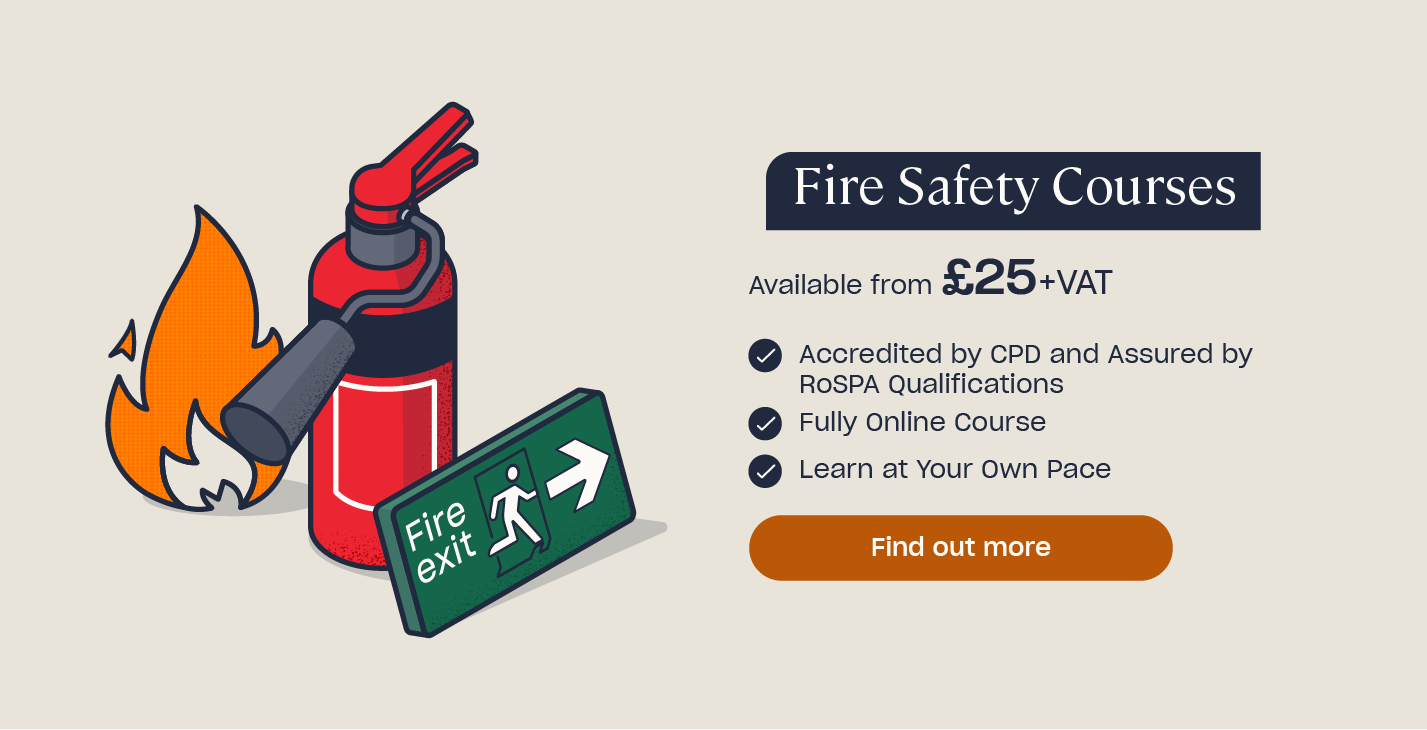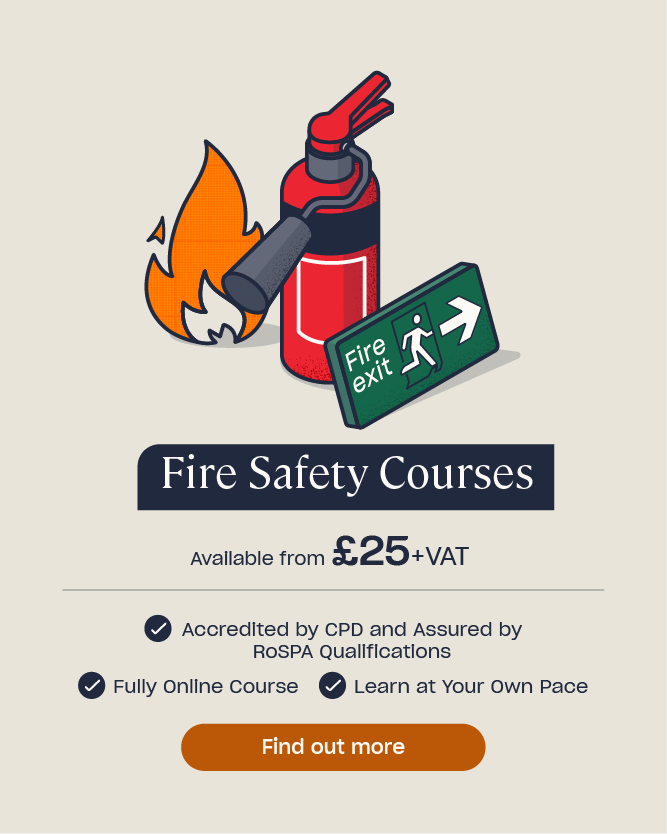Report: Fire Safety in the Home

We are High Speed Training, and since 2008, we’ve supported over 2 million learners to achieve their personal and professional goals in the workplace and beyond.
Fire safety is a topic that, sadly, is rarely off the agenda. The fire services in England, Scotland and Wales attend more than 600,000 incidents each year, tragically resulting in around 300 fatalities, if not more. [1]
Many of these incidents occur in the home. In fact, 20 people are injured or killed every day just by accidental fires that start in their kitchens. [2]
Fire services across the country recommend a number of simple and practical steps that can be taken to reduce the risk of a fire breaking out in your home, and also decrease the chances of being injured in a fire should one occur.
We wanted to explore some of these potentially life-saving pieces of advice, and seek to understand how the public could better protect themselves, their homes, and their families.
We undertook a survey of over 2000 UK adults to find out how often this advice is being put into practice by the public, and identify any areas that could be improved to make our homes safer.
The stats that High Speed Training have found show that many households across the UK could be doing more to reduce the risk of a fire breaking out in their homes. There is a real need to raise awareness of what can be done to improve fire safety across the country.
By following the advice suggested in this report and by fire services across the country, we can decrease the risk of serious and potentially fatal fires occurring in our homes.
William Cunningham MIFSM, MIIRSM, GradIOSH, DipFD, Director of Safety Group and Fire Safety Consultant
1. Smoke Alarm Testing
Smoke alarms are perhaps one of the most important inventions of the 20th century. They are designed to give you that vital early warning needed to help you escape your property and call the emergency services in good time.
Interestingly, they were an accidental invention during the late 1930s by a Swiss physicist named Walter Jaeger. After originally attempting to design a sensor that could identify poisonous gas, he lit a cigarette and discovered that his design could instead detect smoke particles. Since then, smoke alarms have become a staple in countless households and workplaces.
However, this creation was very expensive at first, preventing them from being used commercially until 1965. Stanley Bennett Peterson and Duane Pearsall then transformed the invention into a home smoke detector – cheap enough to be installed in most homes and allowing it to become widely used by the 1970s.
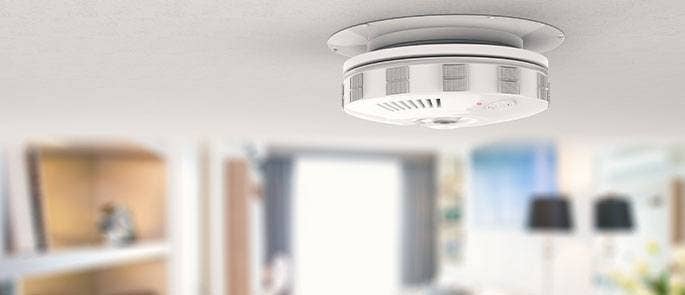
Did you know that nowadays there are four main types of smoke alarms?
- Ionisation – one of the most common types of smoke alarms.
- Optical alarms (photoelectric) – also one of the most commonly used types.
- Heat alarms, which are not sensitive to smoke.
- Combined alarms, such as combined optical smoke and heat.
In a recent survey of over 2000 UK adults, we found that only 5% do not have a smoke alarm in their homes. Without one, you are 8 times more likely to die in a fire.
Whilst owning a smoke alarm takes you one step closer to remaining safe in the event of a fire, they do still have to be tested regularly. It is recommended that you test your smoke alarms every week. [3]
Surprisingly, most individuals (96%) are not testing regularly enough, with 85% testing less than once a month and 12% never testing at all. In addition to this, we learnt that many (17%) of the younger generation (18-34s) do not test either. Whereas, those over 55 are far more likely to test once a month.
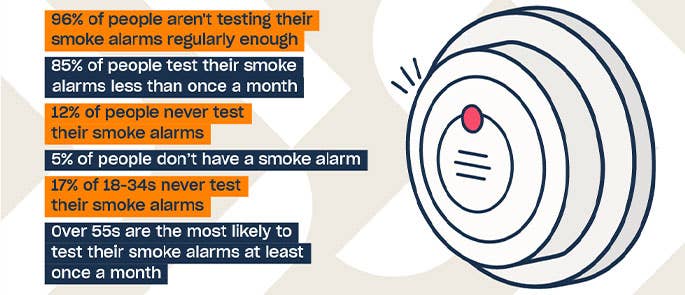
These results suggest that the younger generation needs more awareness on the importance of smoke alarms in fire safety.
Testing your smoke alarms weekly and carrying out routine maintenance, such as removing debris and checking the batteries, is the easiest way to make sure your home is protected. Smoke alarms degrade over time and generally have a life span of around 10 years. You should check manufactures information for the exact lifespan of your devices and look to change them when required.
2. Smoke Alarm Placement
Fires can start for a number of different reasons. Around half of home fires are caused by cooking incidents, with 3 fires a day starting from heaters, and 2 from candles. But that’s not all: around 4,000 home fires originate from faulty appliances. These can happen in any room of your home, which is why smoke alarm placement could be key to your safety.
So, where does your smoke alarm live? Good smoke alarm positioning is crucial in order to ensure effective detection in the event of a fire. However, we found that only 84% of those we surveyed have one on every level, dropping to 70% among those aged 18-24 years old.
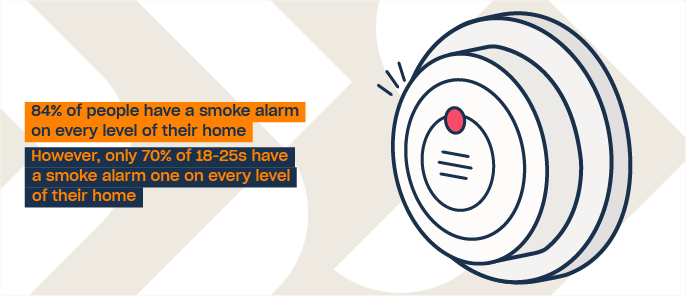
In private rented and social rented homes, it is the duty of the landlord to ensure a suitable number of smoke alarms are installed and functional at the beginning of the tenancy. As set out by the Smoke and Carbon Monoxide Regulations, they must ensure at least one smoke alarm is equipped on each storey of homes where there is a room used as living accommodation. They must also address any issues if reported by tenants.
In privately owned homes, it is down to the owner to arrange for their own smoke alarms to be fitted. They can either fit the alarms themselves or arrange for a qualified person to come and install them.
There are no specific legal requirements regarding the positioning of smoke alarms, though it states that one should be on every storey, as mentioned earlier. This also means that there is no legally required quantity, as this depends on the size of the property.
However, there is some general advice that can be followed by those responsible for installing fire alarms, to maximise cover and therefore safety. Since fires can start anywhere, the more that are fitted, the higher the level of protection.
For example, a smoke alarm in every room of the house would provide maximum protection, while minimum protection would be a smoke alarm on each floor of the house. The only exception to this is bathrooms. Smoke alarms should be avoided in bathrooms as they may become susceptible to unwanted tripping from the steam.
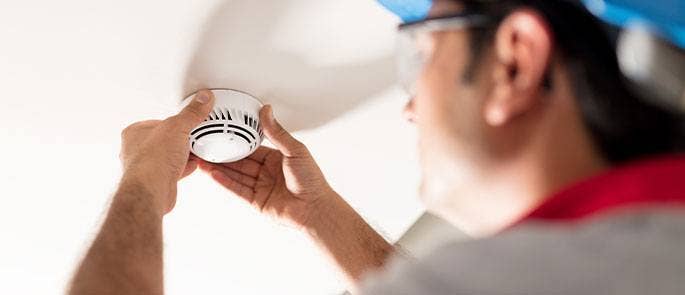
Other places to avoid or take extra care when placing smoke alarms include:
- Corners of the ceiling.
- Close to fans.
- Sloping ceilings.
In contrast, the best places to fit smoke alarms are:
- Kitchens.
- Landings.
- Bedrooms.
- Ceiling beams.
Every home is unique, meaning the number of smoke alarms needed depends hugely on the home’s layout. Generally, fitting detectors to the centre of the ceiling either via screws or specialist sticky pads is the way to go – as long as they are at least 30cm away from any wall, light fitting, or obstruction. [4]
If the home has one level, the most efficient place to install smoke alarms is in the hallway between the living and sleeping areas. Furthermore, having a detector 3m away from every bedroom door helps to ensure audibility. If smoke detectors are in an area where they can be heard, they will be more effective in the event of a fire.
3. Escape Plan
Your chances of surviving a fire within your home depend heavily on advance planning. In the smoky and scary environment of a fire in the home, it can be easy to panic and become disorientated. Therefore, it’s recommended to have a thorough pre-planned escape route from your house, by which you and others can safely exit the property. But what makes a good escape plan?
The main key to a good fire escape plan is to include alternate routes to safety in case one exit is blocked or dangerous to use. The shortest, most direct way out is always best, but the more ways you identify to exit each room of your house, the more chance you have of escaping a fire. Secondly, the more frequently you practise your escape plan, the easier it will be to put it into action when needed.
eScooters, eBikes or any large Li-ion batteries should not be charged or stored on escape routes or at the base of stairs. Should these items start a fire the escape route and stairs would become immediately filled with smoke.
Despite the importance of having a fire escape plan prepared, in a survey of over 2000 adults we found that the majority (55%) don’t have a plan. Additionally, it seems to be younger generations that are the least prepared, with 68% of 18-24 year olds saying they don’t have or don’t know if they have a plan. In contrast, 45-55 year olds are most likely to have a plan, with 51% stating they have an escape route prepared.
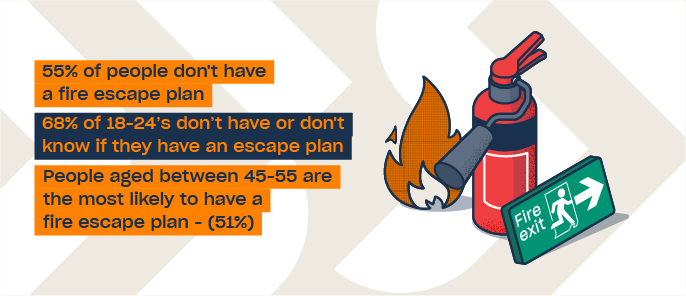
These results suggest that more people, particularly those of a younger age, need more awareness on the importance of having a fire escape plan. One example of an influential adult raising awareness successfully is Myleene Klass, who recently shared a TikTok video with over 450k views of her and her young children doing a monthly fire drill in their London home. In the video, the children are blindfolded and made to crawl around the house on all fours to practise different escape routes.
Klass’s video helps spread awareness of what a good fire escape plan involves, and also encourages families to discuss and practise pre-arranged fire safety procedures, including various escape routes.
Do you have your fire escape routes planned yet? If not, start thinking about the floor plan of your home and possible ways out of each room. You never know when it might prove to be a life-saving precaution.
Over the last few years, we have all spent more time at home. It is so important that we make sure that our homes are as safe as possible, minimising the risks of a fire breaking out, and maximising our chances of escaping safely if one does.
William Cunningham MIFSM, MIIRSM, GradIOSH, DipFD, Director of Safety Group and Fire Safety Consultant
4. Amperage and Voltage
Faulty electrics, including appliances, wiring, and overloaded sockets, cause around 4,000 house fires in England every year. [5] Overloaded extension leads are a frequent culprit of fires, as it’s often unknown that it’s not always safe to fill all the sockets supplied on the cable. A socket can become overloaded if you plug in appliances that together will exceed the maximum current rating stated for the extension lead. This could result in the plug in the wall socket overheating and causing a fire.
One way to avoid this happening in your home is to check the maximum voltage and amperage levels for all sockets and extension leads, to ensure you don’t overload them. But how many people actually know how to do this?
In our survey of over 2000 people, a worrying 77% stated they don’t know how to check either the voltage or the amperage levels of a socket, and between the ages of 18-24, only 16% said they knew how to find this information. For people over 45, this percentage increased to 27%, but this is still an alarmingly small percentage for such an important skill.
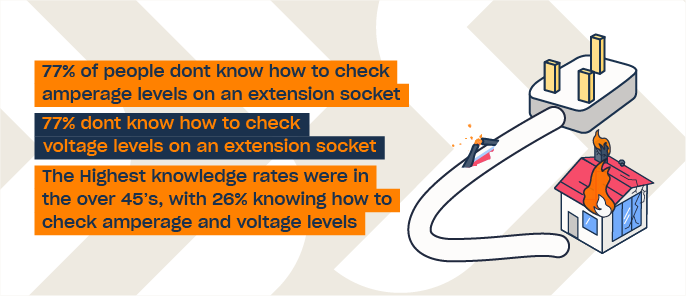
Data from Zurich Insurance showed blazes sparked by electric vehicles powered by lithium batteries, such as eScooters or eBikes, had risen by 149% from 67 in 2020 to 167 in 2022. [6] Li-ion battery fires can start for a number of reasons and usually start spontaneously. Damage to the battery, faulty chargers and attempting to charge immediately after use when the battery cell is still hot are all factors which can increase the likelihood of fire. Where possible, store these items outside or in a garage. Failing this, store in a room which has smoke detection and a door which closes off the escape route.
So, how do you check that a socket is not overloaded? The maximum current allowed to safely flow through the socket (power rating) should be clearly marked on the back or underside of the extension lead. If not, you should refer to the manufacturer’s instructions.
To find out if your socket is overloaded, simply calculate the sum of the amperages marked on the back of each appliance plugged in and check it doesn’t exceed the power rating of the socket. A guide to power ratings of commonly used household appliances can be found here. You can also use this socket calculator to see if you are overloading your sockets.
There are a number of warning signs you can look out for which suggest a socket may be at risk of causing a fire. These include:
- A burning plastic smell near an appliance or socket.
- Sparks or smoke coming from a plug or appliance.
- Black or scorch marks around a socket, plug, or appliance.
- Damaged or frayed leads.
- Melted plastic on appliance casings or leads.
Following the manufacturer’s instructions and ensuring you’re not overloading sockets and extension leads will ensure you reduce the risk of electrical fires starting in your home.

5. Night Time Routine
Over half of all deaths caused by fires in the home happen between 10pm and 8am. [7] A fire occurring at night can be more dangerous, as you will likely respond much slower than you would while awake and therefore have less time to escape. Working smoke alarms are essential to ensuring you are alerted quickly, but there are some other simple things you can do to reduce the risks.
Because of an increase in synthetic materials and furniture, fires can spread incredibly quickly. According to Closeyourdoor.org, the average time you would have to escape a fire 40 years ago was 17 minutes. Today, it is only three minutes.
Closing all of the internal doors in your home is one way to increase your chances of being able to escape from a house fire. However, in our survey, we found that 66% of people don’t close their internal doors every night. If a fire breaks out in one room of your home, a closed door can hold back fire and smoke, and buy you precious time to escape.
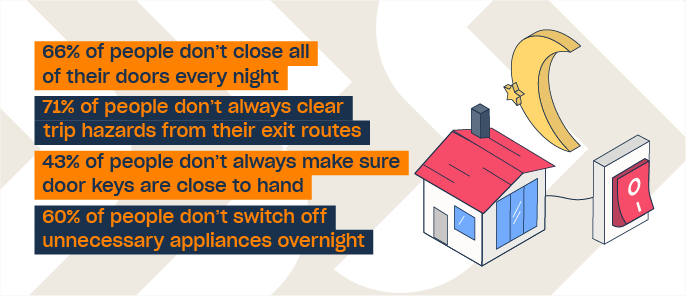
As discussed earlier, electrical appliances are one of the leading causes of fires in homes in the UK. By switching off unnecessary appliances overnight, you reduce the risk of a fire breaking out whilst you sleep. Dishwashers and washing machines pose a fire risk due to their high wattage, friction and motors, so it is recommended to not run these machines overnight.
Another simple step to add to your routine is to make sure that your exit route is clear of trip hazards. In the disorientating smoke of a house fire, objects on the floor could pose a real risk. This could be wires, shoes, bags – anything that you could potentially trip over should be cleared away to allow you to exit your home in a prompt and safe manner. Our survey found that a huge 71% of respondents don’t clear their exit routes every night.

In an emergency situation, it’s crucial to know the right steps to take to be able to exit a building safely. We’ve already discussed an escape plan, but one of the most important aspects of this is knowing exactly where the keys to your exit doors are. They ideally should be in a memorable place that you will be able to easily and safely access. In our survey, we found that 43% of people don’t always leave their keys to hand, potentially creating a scenario in which they are not able to safely exit their property in the event of a fire.
The stats that High Speed Training have found show that many households across the UK could be doing more to minimise the risk of a fire breaking out in their homes.
As a member of the fire service, I can honestly say following the steps in this report will make your home safer. If you have smoke alarms, please test them regularly and make sure they work. If you don’t currently have smoke alarms in your home, you need to get some.
If you need any advice about fire safety, your local fire station will be available for guidance and assistance relating to safety in the home and other safety related issues.
Dave Dixon, Station Manager at North Yorkshire Fire Service
Having spent over 15 years working in fire safety, I can say that the steps included in this report, such as regularly testing properly placed smoke alarms, ensuring you have an escape plan, and not overloading sockets, are simple and practical ways to improve the fire safety of your home.
William Cunningham MIFSM, MIIRSM, GradIOSH, DipFD, Director of Safety Group and Fire Safety Consultant
Though there will always be a risk of fires breaking out in the home, there are a number of practical steps you can take to reduce the chances of a fire occurring, and to mitigate the risk of sustaining serious injuries in the event of an emergency.
Our research shows that many of these potentially life-saving steps are not being carried out by members of the British public, leaving them at greater risk of suffering serious injuries in a domestic fire.
However, it also presents an opportunity to raise awareness of what can be done to improve fire safety across the country.
If you would like to learn more about what you can do to improve the fire safety of your home, visit the website of your local fire service for simple and free advice. Many services also offer a free home visit to assess your property and offer suggestions on making sure your home is as safe as it can be.
Methodology
All survey figures are from YouGov Plc. Survey commissioned by High Speed Training. Total sample size was 2042 adults. Fieldwork was undertaken in July 2022. The survey was carried out online. The figures have been weighted and are representatives of all GB adults (18+).
References
[3] https://www.westyorksfire.gov.uk/safety/smoke-alarms
[4] https://www.cambsfire.gov.uk/home-safety/smoke-alarms/
[6] Freedom of Information data obtained by Zurich from 36 and of 45 fire authorities in the UK. Data for 2022 collected to end of September.
[7] https://www.clevelandfire.gov.uk/safety/home-safety/bedtime-routine/
Further Resources:
- Understanding the Different Types and Uses of Fire Extinguishers
- What Does PASS Stand For? Fire Extinguisher Use and Safety
- Fire Safety Signs
- Fire Safety Courses


